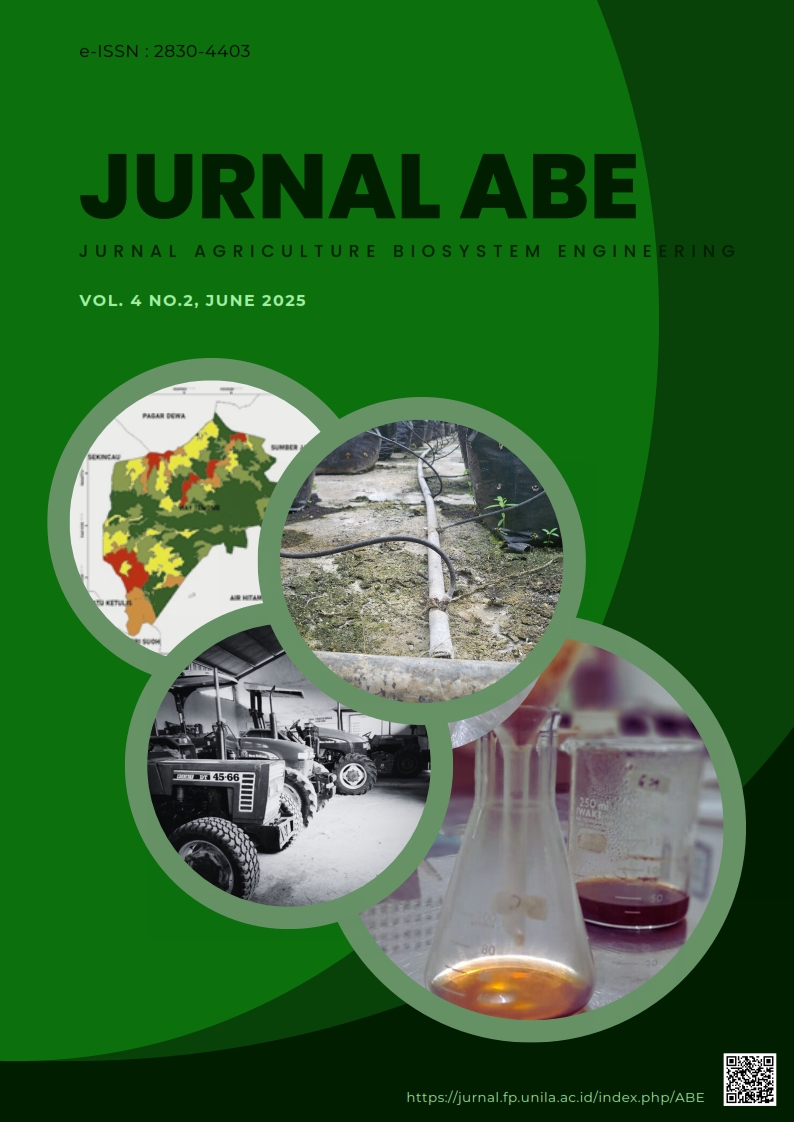Uji Kinerja Alat Chopper Serbaguna Untuk Merajang Batang Singkong Varietas Bayeman
DOI:
https://doi.org/10.23960/jabe.v4i3.11591 Abstract View: 69
Abstract View: 69
Keywords:
Cassava stick, RPM, ChoppingAbstract
Cassava production not only produces tubers and leaves that can be used as
vegetables, but there is also waste produced, one of which is cassava stems. So
far, cassava stem waste has not been widely utilized by farmers, so after the
cassava is harvested, the cassava stems are just left lying on the land. This study
aims to reduce cassava stem waste by reducing the size using a multi-purpose
Chopper tool with several variations in engine rotation per minute (RPM). This
research was conducted at the Agricultural Machinery and Equipment Power
Laboratory, Department of Agricultural Engineering, Faculty of Agriculture,
University of Lampung in March 2025. The treatment used 3 variations of RPM,
namely 1500, 1800, and 2100 where each used 3 different input amounts, namely:
input of 3 stems, 4 stems, and 5 stems and each RPM was repeated 3 times. The
results showed that chopping using the RPM setting of 2100 and the input amount
of 4 cassava stems had the best work capacity with a value of 150.8 kg/hour. The
lowest fuel consumption using RPM variation of 1500 and the amount of input of
3 sticks with a value of 591.6 ml/hour.
Downloads
References
Ahmad, S., Wahyudi, S., dan Setiawan, B. (2019). Penggunaan Chopper Mini dalam Industri Pertanian. Jurnal Teknologi Pertanian, 18(2), 45-56.
Asmara, S., Kuncoro, S., dan Zulkarnain, I.(2019). Pelatihan Penanganan Limbah Batang Singkong Menggunakan Mesin Perajang Batang Singkong (Rabakong) Di Desa Tanjung Bulan, Kecamatan Kasui, Way Kanan. Jurnal Pengabdian Masyarakat, 69-74.
Badan Pusat Statistik. 2023. Data Jumlah Produksi Singkong Indonesia. www.BPS.com. Diakses pada 29 November 2020.
Chen, L., Zhang, X., and Li, Y. (2020). Design Innovations in Mini Choppers. Agricultural Engineering Journal, 25(3), 121-134.
Gomes, R., Silva, T., and Almeida, F. (2020). Optimization of cassava processing parameters. Journal of Food Engineering, 45(2), 89–104.
Hidayat, A., Rahman, T., dan Sutrisno, E. (2018). Performance Evaluation of Mini Choppers on Cassava Stalks. Journal of Agricultural Research, 17(1), 67-78.
Halim, M., Prasetyo, R., dan Handayani, R. (2022). Economic Benefits of Mini Chopper in Agriculture. Agricultural Economics Review, 19(2), 89-102.
Ikelle, I.I., Nworie, F.S., Ogah, A.O., andIlochi, N.O. 2017. Study On The CombustionPropertiesof Bio-Coal BriquetteBlendsOfCassavaStalk. ChemSearch. Journal. Vol. 8 No.2 : 29-34.
Juliantoro. R. (2023). Pengaruh RPM dan Jumlah Masukan Batang Singkong Terhadap Kinerja Mesin Rabakong Tipe Tep-6. Universitas Lampung. Bandar Lampung.
Kusuma, D., Susanto, J., dan Wibowo, P. (2019). Safety and Ergonomics in Mini Chopper Usage. Journal of Agricultural Safety, 14(4), 203-215.
Mott, R.L. 2009. Elemen-Elemen Mesin Dalam Perancangan Mekanis Perancangan Elemen Mesin Terpadu. Yogyakarta: ANDI YOGYAKARTA.
Nurhadi, A., Susilawati, E., dan Wibowo, T. (2017). Blade Size and Chopping Efficiency. Journal of Mechanical Engineering, 22(1), 55-66.
Purwono, dan Purnamawati, H. 2007. Budidaya 8 Jenis Tanaman Pangan Unggul. Depok: Penebar Swadaya.
Purwono. 2009. Budidaya 8 Jenis Tanaman Unggul. Penebar Swadaya. Jakarta.
Putra, H., Wibowo, P., dan Susanto, J. (2020). Material Selection for Mini Choppers. Journal of Material Science and Engineering, 15(3), 149-162.
Rahardjo, B., dan Hidayat, T. (2020). Ergonomicsin Agricultural Machinery. Journal of Agricultural Ergonomics, 11(2), 78-92.
Rahman, T., Wahyudi, S., dan Prasetyo, R. (2021). Energy Efficiency in Agricultural Choppers. Journal of Sustainable Agriculture, 26(1), 110-123.
Santoso, D., Halim, M., dan Ahmad, S. (2021). Applications and Economic Impact of Mini Choppers. Journal of Agricultural Economics, 24(2), 112-127.
Setiawan, B., Hidayat, T., dan Wahyudi, S. (2017). Cutting Efficiency in Agricultural Choppers. Journal of Agricultural Engineering, 19(1), 89-98.
Siswati, L., Ardie, S. ., dan Khumaida, N. 2019. Pertumbuhan dan Perkembangan Ubi Kayu Genotipe Lokal Manggu pada Panjang Setek Batang yang Berbeda. Jurnal Agron. Indonesia, 47(3), 262–267.
Subandiro. 2009. Mesin Konversi Energi. Andi.Yogyakarta.
Sumada, K., Tamara, P. E., Alqani, F. 2011. Isolation study ofefficient αcellulosefromwasteplantstemmanihotesculentacrantz. Jurnal Teknik Kimia. (1)5: 434 – 438.
Susilawati, E., dan Rahardjo, B. (2018). Environmental Impact of Mini Choppers. Journal of Environmental Science, 16(3), 144-159.
Wahyudi, A., Hasanah, R., dan Prasetyo, B. (2018). Effect of mechanical speed on agricultural product wast e reduction. Agricultural System, 33(4), 210–225.
Downloads
Published
How to Cite
Issue
Section
License
Copyright (c) 2025 Sandi Asmara, Tamrin Tamrin, Rizky Zakaria

This work is licensed under a Creative Commons Attribution-NonCommercial-ShareAlike 4.0 International License.
Authors who publish with this journal agree to the following terms:
Authors retain copyright and grant the journal right of first publication with the work simultaneously licensed under a Creative Commons Attribution-ShareAlike 4.0 International Lice that allows others to share the work with an acknowledgement of the work's authorship and initial publication in this journal.
Authors are able to enter into separate, additional contractual arrangements for the non-exclusive distribution of the journal's published version of the work (e.g., post it to an institutional repository or publish it in a book), with an acknowledgement of its initial publication in this journal.
Authors are permitted and encouraged to post their work online (e.g., in institutional repositories or on their website) prior to and during the submission process, as it can lead to productive exchanges, as well as earlier and greater citation of published work (See The Effect of Open Access).
Jurnal Agricultural Biosystem Engineering

JABE is licensed under a Creative Commons Attribution-ShareAlike 4.0 International License.




